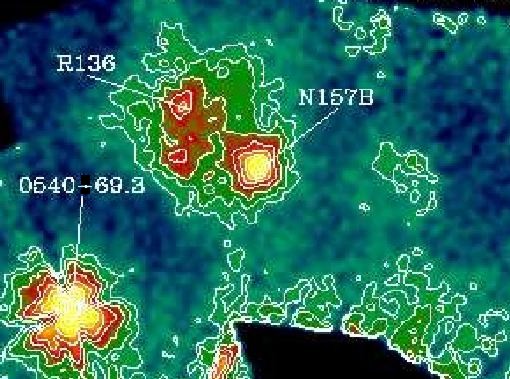Explanation: Pulsars are rotating neutron stars, born in the violent crucibles of supernova explosions. Like cosmic lighthouses, beams of radiation from surface hotspots sweep past our viewpoint creating pulses which reveal the rotation rates of these incredibly dense stellar corpses. The most famous pulsar of all is found in the nearby supernova remnant, the Crab Nebula. The Crab's young pulsar is fast. Rotating at 33 times a second, its radiation energizes the surrounding gaseous stellar debris. But using archival observations from orbiting X-ray telescopes, astronomers have recently identified another "Crab-like" pulsar that is even faster. Located in the Large Magellanic Cloud (LMC), X-ray pulses from this newly discovered pulsar, in the supernova remnant N157B, indicate an even faster rotation rate - 62 times a second - making it the fastest known pulsar associated with a supernova remnant. This contoured, false color X-ray image of a portion of the LMC shows the location of N157B along with the core of the nearby hot star cluster R136, and the site of another Crab-like pulsar in SNR 0540-69.3 (rotating a mere 20 times a second). The image is about 1,500 light-years across.
1999 2000 2001 2002 2003 2004 2005 2006 2007 2008 2009 2010 2011 2012 2013 2014 2015 2016 2017 2018 2019 2020 2021 2022 2023 2024 2025 |
Yanvar' Fevral' Mart Aprel' Mai Iyun' Iyul' Avgust Sentyabr' Oktyabr' Noyabr' Dekabr' |
NASA Web Site Statements, Warnings, and Disclaimers
NASA Official: Jay Norris. Specific rights apply.
A service of: LHEA at NASA / GSFC
& Michigan Tech. U.
|
Publikacii s klyuchevymi slovami:
pulsar - supernova remnant - ostatok Sverhnovoi - Pul'sar - pul'sar v Krabe - Krabovidnaya tumannost' - Bol'shoe Magellanovo Oblako - Sverhnovye
Publikacii so slovami: pulsar - supernova remnant - ostatok Sverhnovoi - Pul'sar - pul'sar v Krabe - Krabovidnaya tumannost' - Bol'shoe Magellanovo Oblako - Sverhnovye | |
Sm. takzhe:
Vse publikacii na tu zhe temu >> | |
